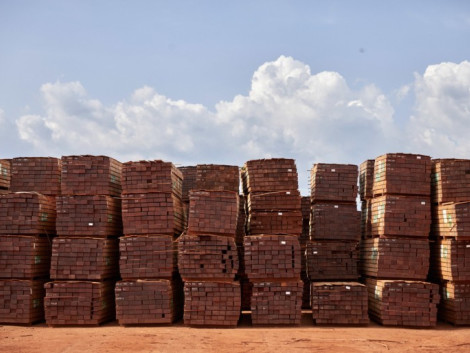

News | 09.12.2022
Here you can find the main trends in tropical timber markets as reported in ITTO's bi-monthly market report.

Tropical timber producing countries formed a coalition to urge consuming countries to recognise the certification system developed in each producing country. The coalition included Indonesia, Guyana, Liberia, Ghana, Republic of the Congo, Cameroon and Gabon. This coalition was announced at the Indonesian Pavilion at the UNFCCC/COP27.
The coalition consists of countries that have introduced a tracking/legality certification system as part of preparations for a Voluntary Partnership with the European Union.
West and Central Africa
It is reported that most sawmills in Gabon and Cameroon are back in production but output has been cut in many mills due to the decline in orders for the Chinese market. To drive output mills have begun cutting more for the European (azobe for Holland, for example) and Middle East markets.
As is usually the case when there is a slowdown in a major market stocks tend to rise and this ultimately leads to weaker price levels where there is still some demand.
Across the region the weather patterns have been disturbed and operators are looking forward to the start of the dry season. There are reports that as much as 50% of logging trucks have been parked as it is impractical to operator under the current bad conditions. However, if logs make it to the rail-head there are ample opportunities for rail transportation.
Who owns the carbon stock?
The value of carbon is starting to appear in calculations of forest revenue in Gabon and this is being actively promoted by certification organisations. For concession holders, the issue that now needs clarification is: who owns the carbon, the government which owns the forest or the concessionaires who have harvesting rights?
The rise in mining operations in forest areas, especially in Gabon and Congo, has led timber companies to raise the alert because of the damage being done to the forest which they say is far above any short-term degradation caused by logging.
Asia
PEFC International invited the Malaysian Timber Council (MTC) to participate in the “PEFC-For Trade” regional conference and dialogue held in Ho Chi Minh. The event attracted the participation of various international and South East Asian stakeholders including countries such as Cambodia, Laos, Myanmar, Thailand, Malaysia and Australia. The conference gathered all the stakeholders involved in the UN-REDD project with the goal to increase national commitment for legal and sustainable trade in wood products.
In related news, The Malaysian Timber Certification Council (MTCC) will organise a PEFC Chain of Custody Training Course for
PEFC-Notified Certification Bodies under the MTCS.
On 8 November a World Bank press release announced that Indonesia has received an advance payment of US$20.9 million under the Emissions Reduction Payment Agreement between the Government of Indonesia and the World Bank’s Forest Carbon Partnership Facility (FCPF) for reducing emissions from deforestation and forest degradation (REDD+) in East Kalimantan Province. Under the Agreement, Indonesia would receive up to US$110 million for verified emissions from reducing deforestation and forest degradation. Indonesia has become the first country in the East Asia Pacific Region to receive payments through the World Bank’s FCPF. The full payment will be released once the independent third-party verification of the reported emissions reductions, which is currently ongoing, is complete.
Europe (EU27)
EU27 imports of wood and wooden furniture increased in the first nine months 2022 from all the main tropical supply countries.
Both value and volume of imports increased from Cameroon (+19% to US$216M, +21% to 220,200 tonnes), Gabon (+30% to US$235M, +26% to 210,000 tonnes), Indonesia (+27% to US$809M, +5% to 208,200 tonnes), Brazil (+58% to US$285M, +31% to 191,100 tonnes), Vietnam (+20% to US$712M, +5% to 169,200 tonnes), Malaysia (+36% to US$335M, +9% to 125,900 tonnes), Republic of Congo (+3% to US$81M, +8% to 86,200 tonnes), and Cote d'Ivoire (+10% to US$48M, +2% to 36,600 tonnes).
Trends into the main import destinations for tropical wood and wooden furniture were: France (+29% to US$670M, +9% to 294,400 tonnes); Netherlands (+14% to US$652M, +10% to 261,700 tonnes); Belgium (+29% to US$552M, +14% to 370,500 tonnes); Germany (+16% to US$533M, no change at 153,000 tonnes); Italy (+46% to US$269M, +43% to 146,900 tonnes); Spain (+36% to US$190M, +36% to 81,600 tonnes); Denmark (+17% to US$142M, +5% to 34,900 tonnes).
After two slow years during the global pandemic, EU27 imports of tropical sawnwood have recovered ground this year.
The EU27 imported 88,100 cubic metres of tropical logs with value of US$47M in the first nine months of this year, respectively 18% and 15% more than the same period last year. EU27 log imports increased from all three of the largest African supply countries in the first nine months of this year compared to the same period last year; Congo (+6% to 35,500 cubic metres), CAR (+41% to 18,100 cubic metres), and DRC (+87% to 10,700 cubic metres). This raises the question of how European imports will evolve when the log export ban comes into effect in the CEMAC countries.
***
For detailed news on international tropical timber markets, please refer to the ITTO Market Report for the second half of November.
tag(s) :